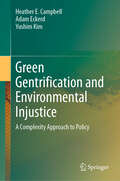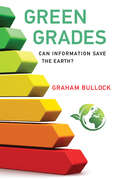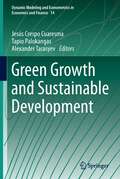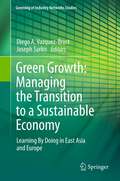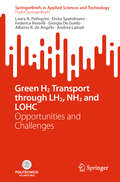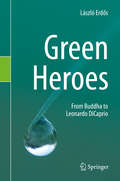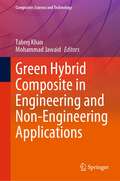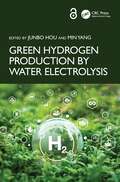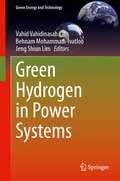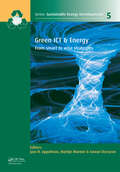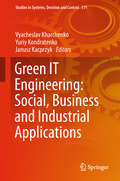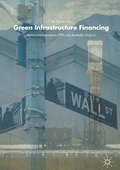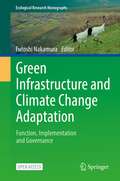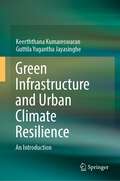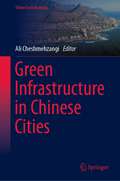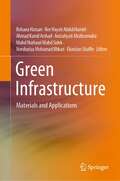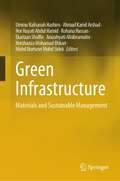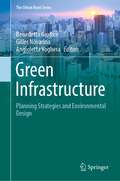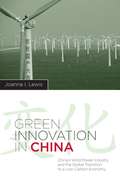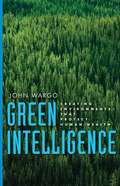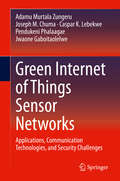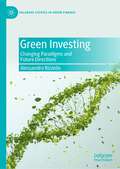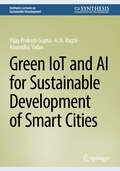- Table View
- List View
Green Gentrification and Environmental Injustice: A Complexity Approach to Policy
by Heather E. Campbell Yushim Kim Adam EckerdThis book argues that, given the complex nature of the urban environment, we cannot find one optimal solution to reducing environmental injustice, in part because there is no singular cause. Environmental injustice emerges in particular settings because of the combined and interdependent effects of a variety of different policy and community characteristics. The authors argue that addressing these interlinked problems requires an understanding of the clusters of community and contextual factors that combine in a variety of ways to both create problems and imply policy approaches to managing them. They argue for the use of complexity-informed methods to assist in making public policy choices, such as Qualitative Comparative Analysis (QCA) and Agent-based Modeling (ABM), to enable us to better identify plausible solutions for specific contexts. This volume offers a new perspective for strategically managing urban policy that considers the risk of gentrification and gentrification-related displacement, with the ultimate goal of improving social justice. Environmental injustice, pollution remediation, gentrification, and displacement are interlinked problems, all of which impinge on social justice in US cities. However, public policy research, and often practice as well, has tended to separately consider urban policy issues such as environmental injustice, brownfields and other pollution remediation, how to redevelop neighborhoods, and how to contend with gentrification and displacement. In this book the authors take a new perspective to such intertwined urban policy issues, using complexity thinking and, more importantly, complex adaptive systems approaches, in order to develop context-sensitive policy approaches to managing these ongoing problems.
Green Grades: Can Information Save the Earth?
by Graham BullockA comprehensive assessment and analysis of the validity, trustworthiness, and effectiveness, of such environmental ratings as ENERGY STAR, LEED, and USDA Organic. Consumers are confronted with a confusing array of environmental ratings on products that range from refrigerators to shampoos. Is the information that these ratings represent trustworthy, accurate, or even relevant to environmental concerns? “Information optimists” believe that these “green grades” can play an important role in saving the planet. “Information pessimists” consider them a distraction from pursuing legislative and regulatory actions. In this book, Graham Bullock offers a comprehensive assessment and analysis of the effectiveness and validity of such environmental ratings as ENERGY STAR, USDA Organic, the Forest Stewardship Council, LEED, and the Toxic 100 Air Polluters Index. Bullock stakes out a position as an “information realist,” acknowledging both the contributions and the limitations of these initiatives. Drawing on interviews, case studies, and an original dataset of 245 environmental ratings and certifications, he examines what he calls the information value chain of green grades: organizational associations, content, methods, interfaces, and outcomes. He explores the relevance of the information to the issues; the legitimacy and accountability of sponsoring or cooperating organizations; the reliability of methods used to develop the information; the prominence and intelligibility of communication to the public; and the effects and effectiveness of the information after it emerges from the value chain. Bullock's analysis offers a realistic appraisal of the role of information-based environmental governance—its benefits and shortcomings—and its relation to other governance strategies.
Green Growth and Sustainable Development
by Tapio Palokangas Jesús Crespo Cuaresma Alexander TarasyevThe book examines problems associated with green growth and sustainable development on the basis of recent contributions in economics, natural sciences and applied mathematics, especially optimal control theory. Its main topics include pollution, biodiversity, exhaustible resources and climate change. The integrating framework of the book is dynamic systems theory which offers a common basis for multidisciplinatory research and mathematical tools for solving complicated models, leading to new insights in environmental issues.
Green Growth: Learning By Doing in East Asia and Europe
by Joseph Sarkis Diego A. Vazquez-BrustThis volume is a practical guide that helps the reader build a quick, evidence-based understanding of green-growth strategies and challenges. Its cogent analysis of real-life case studies enables policy makers and company executives identify successful strategies they can adopt, and pitfalls they can avoid, in drafting and implementing green growth policies. The contributors' empirical assessment of these studies identifies the structural conditions required for economic growth to be compatible with environmental sustainability and how the transition to a new economic paradigm should be managed. A crucial addition to the debate now beginning in earnest around the world, this volume attempts to understand how we can nurture a new-born model of sustainable growth and help it evolve to maturity.
Green H2 Transport through LH2, NH3 and LOHC: Opportunities and Challenges (SpringerBriefs in Applied Sciences and Technology)
by Laura A. Pellegrini Elvira Spatolisano Federica Restelli Giorgia De Guido Alberto R. de Angelis Andrea LainatiThis book explores the opportunities and challenges of hydrogen transport through different carriers (i.e., liquefied hydrogen, ammonia, toluene, and dibenzyltoluene). Each value chain analyzed includes: renewable H2 conversion to the carrier, storage of the hydrogenated carrier, its seaborne transport, reconversion of the carrier to produce H2 and hydrogen distribution. The conversion and reconversion processes are the cost drivers of the whole value chain. These stages are investigated through an in-depth techno-economic assessment, to highlight the critical issues and the need for further investigation (low TRL). The alternatives are examined considering: different H2 applications (industrial and mobility sector); different costs of utilities (present and future scenarios); and different distances from the loading to the unloading terminal. All these scenarios are discussed and compared by means of the levelized cost method, to understand which is the most cost-effective choice for each case study. As a result, H2 application to the industrial sector shows the lowest costs, with ammonia being the best alternative for transporting and storing hydrogen in this case. Liquefied hydrogen is the most expensive H2 carrier for the industrial application, as a consequence of the high liquefaction costs while holding promises for the mobility sector.
Green Heroes: From Buddha to Leonardo DiCaprio
by László ErdősThis book provides an introduction into the diversity of the environmental movement through great characters in the green sector. The book describes inspiring personal achievements, and at the same time it provides readers with information regarding the history, the main directions and the ethical principles of the environmental movement. Some of the most important characters of the movement from all around the world, are included in the book. As well as the title characters, Buddha and Leonardo DiCaprio, other famous environmentalists like Albert Schweitzer, David Attenborough and Jane Goodall are discussed. Some of the less well-known but equally important environmentalists such as Chico Mendes, Bruno Manser, Henry Spira, Tom Regan or Rossano Ercolini are highlighted in the various chapters. The selection of characters represents all major branches within the green sector, ranging from medieval saints to Hollywood celebrities, from university professors to field activists, from politicians to philosophers, from ecofeminists to radicals.
Green Human Resource Management: A View from Global South Countries
by M. Y. Yusliza D. W. S. RenwickThis book offers a fresh perspective on Green Human Resource Management (Green HRM) by focusing on the Global South's industries and cultures. It takes a scientific approach, using evidence to show how sustainable practices in HR can promote environmental goals. The book contributes significantly to the understanding of both the theory and real-world impact of Green HRM. The book offers a wealth of information on various approaches making it not only an intriguing read but also an informative and insightful reference for Green HRM experts all over the world.
Green Hybrid Composite in Engineering and Non-Engineering Applications (Composites Science and Technology)
by Mohammad Jawaid Tabrej KhanThis book introduces the different advanced hybrid composite materials used in aerospace, automotive, marine, and general engineering infrastructures. It represents the current development processes and applications in aircraft, automobile, and marine structures. This book also contains test cases and their validation using a finite element approach using computer tools. The book also deals with the design approach for innovative hybrid composite materials focused on diverse engineering and non-engineering applications. A detailed review of the state-of-the-art composite materials study presented here would be of interest to scientists, academics, students, and engineers and professionals in general working in the field of advanced composite materials and structures. This book is also useful for Ph.D. research scholars to improve their fundamental understanding of advanced materials and is also suitable for master’s and undergraduate courses on composite materials.
Green Hydrogen Production by Water Electrolysis
by Min Yang Junbo HouThe world’s largest economies have set clear development plans for hydrogen energy. From an Economy, Energy, and Environment (3E) point of view, hydrogen energy can be considered an ideal technology for enabling the energy transition from fossil fuels, restructuring energy systems, securing national energy sources, accelerating carbon neutralization, and driving the development of technologies and industry.Green hydrogen production by water electrolysis is the key for hydrogen energy, and this book offers urgently needed guidance on the most important scientific fundamentals and practical applied technologies in this field.This book:• Details materials, electrochemistry, and mechanics.• Covers ALK, PEM, AEM, and SOEC water electrolysis, including fundamentals and applications.• Addresses trends, opportunities, and challenges.This comprehensive reference is aimed at engineers and scientists working on renewable and alternative energy to meet global energy demands and climate action goals.The Open Access version of this book, available at http://www.taylorfrancis.com, has been made available under a Creative Commons Attribution-Non Commercial-No Derivatives (CC-BY-NC-ND) 4.0 license.
Green Hydrogen in Power Systems (Green Energy and Technology)
by Behnam Mohammadi-Ivatloo Vahid Vahidinasab Jeng Shiun LimGreen Hydrogen in Power Systems examines state-of-the-art applications and the latest developments in technology, protocols, implementation, and application of green hydrogen in power and energy systems. The first book to comprehensively analyze the opportunities and challenges in this field, it brings together global experts from different disciplines to provide a comprehensive study of the role of green hydrogen in power systems of the future and its important role in energy evolution and decarbonization efforts around the world. The book is a multidisciplinary reference for researchers and industry stakeholders who have focused on the field of hydrogen integration into the power and energy systems, as well as researchers and developers from different branches of engineering, energy, computer sciences, data, economic, and operation research fields.
Green ICT & Energy: From Smart to Wise Strategies
by Anwar Osseyran Martijn Warnier Jaco H. AppelmanThis book provides the connection between the growing body of literature on sustainability and the topics of energy and ICT. It aims to show how stakeholders active in this area need to play their part ensuring that the ICT-sector evolves towards a sector that can lead throughgreening by IT and also shows that it cangreen its own IT as well.
Green IT Engineering: Social, Business and Industrial Applications (Studies in Systems, Decision and Control #171)
by Janusz Kacprzyk Vyacheslav Kharchenko Yuriy KondratenkoThis book describes the implementation of green IT in various human and industrial domains. Consisting of four sections: “Development and Optimization of Green IT”, “Modelling and Experiments with Green IT Systems”, “Industry and Transport Green IT Systems”, “Social, Educational and Business Aspects of Green IT”, it presents results in two areas – the green components, networks, cloud and IoT systems and infrastructures; and the industry, business, social and education domains. It discusses hot topics such as programmable embedded and mobile systems, sustainable software and data centers, Internet servicing and cyber social computing, assurance cases and lightweight cryptography in context of green IT. Intended for university students, lecturers and researchers who are interested in power saving and sustainable computing, the book also appeals to engineers and managers of companies that develop and implement energy efficient IT applications.
Green Infrastructure Financing
by Jae Myong KohThis book explores the role of governments and international financial institutions (IFIs) in mitigating the perceived risks in green infrastructure markets of emerging and developing countries. Although green infrastructure is designed to enhance a country’s wealth, the author sheds light on the way that the market is failing to link up institutional investors’ needs for a stable yield with the demands of potentially financially-viable investments in green infrastructure markets. Providing a detailed analysis of the root cause of this market failure, this innovative book offers powerful solutions for developing countries. An essential read for academics of development economics and international finance, as well as practitioners and policy-makers, this book covers topics such as industrial policy, climate governance, carbon markets and capital markets.
Green Infrastructure and Climate Change Adaptation: Function, Implementation and Governance (Ecological Research Monographs)
by Futoshi NakamuraThis open access book introduces the function, implementation and governance of green infrastructure in Japan and other countries where lands are geologically fragile and climatologically susceptible to climate change. It proposes green infrastructure as an adaptation strategy for climate change and biodiversity conservation.In the face of climate change, dams, levees and floodways built as disaster prevention facilities do not sufficiently function against extraordinary events such as mega-floods and tsunami disasters. To prevent those disasters and loss of biodiversity in various ecosystems, we should shift from conventional hard measures to more adaptive strategies using various functions that natural and semi-natural ecosystems provide. Green infrastructure is an interconnected network of waterways, wetlands, woodlands, wildlife habitats and other natural areas that support native species, maintain natural ecological processes, sustain air and water resources and contribute to the health and quality of life for communities and people. Green infrastructure has mainly been discussed from adaptation strategy perspectives in cities and urban areas. However, to protect cities, which are generally situated at downstream lower elevations, we explore the preservation and restoration of forests at headwater basins and wetlands along rivers from a catchment perspective. In addition, the quantitative examination of flood risk, biodiversity, and social-economic benefits described in this book brings new perspectives to the discussion.The aim of this book is to accelerate the transformative changes from gray-based adaptation strategies to green- or hybrid-based strategies to adapt to climate change. The book provides essential information on the structure, function, and maintenance of green infrastructure for scientists, university students, government officers, and practitioners.
Green Infrastructure and Urban Climate Resilience: An Introduction
by Guttila Yugantha Jayasinghe Keerththana KumareswaranThis book aims to cover most subject areas of green infrastructure such as components, multi-functionality, and integration to build environment, contribution to urban sustainability, sustainable and smart city development, urban climate change nexus, green buildings and rating systems, economic assessment, and quantification of green infrastructure. The impending climate crisis, as well as the ongoing COVID-19 pandemic, has highlighted the importance of green infrastructure in and around cities, prompting a call for more functional and sustainable urban planning and design. A number of recent studies have shown that green infrastructure provides a wide range of ecosystem functions and services critical to human well-being and urban sustainability, which is especially important during climatic and health crises. In this book, the authors emphasize the importance of existing green infrastructure in coping with climate change-induced stresses, such as increasing climate variability and extreme temperature and precipitation events, as well as contributing to urban dwellers' physical and mental health. Green infrastructure, in both cases, plays a significant role in providing urban areas with resilience capacity, which is critical to urban sustainability. The authors also emphasize the importance of expanding and improving green infrastructure, particularly in vulnerable areas, through integrative and participatory processes.Appropriate integration of green-gray infrastructure and development of climate resilient cities is the core theme of this publication. Further, it emphasizes sustainable development which has become an imperative requirement to the world to move fore and climate change-built environment nexus, the most critical global crisis. Though several books were published globally on the green infrastructure and urban resilience individually, books are rarely published combining both disciplines. This book identifies and addresses the gap through comprehensively discussing on both interlinked areas which is essential for the sustainable urban development. Further, it explores on urban climate resilience, urban sprawl, urbanization, resilience drivers, essentials of city resilience, policy implications, challenges, and future perspectives. This book is a useful fundamental guide in practical applications of green infrastructure in built environment in sustainability context. Further, it enlightens on the significance of transforming the conventional building construction trend to sustainable urban planning designs and building development, exploring on the strategic pathway on building urban climate resilience while signifying the importance of healthy built environment through discussing on the nexus between climate change and built environment.
Green Infrastructure in Chinese Cities (Urban Sustainability)
by Ali CheshmehzangiSince 2014, and the start of the New-type Urbanization Plan (NUP), we see a turning point in the sustainability agenda of China. One of the main indicators is greening cities and the built environments, which will be covered holistically in this edited book. From the perspective of green infrastructure, in particular, the book approaches key areas of ‘forest city development’, ‘sponge city program’, ‘green roofing’, ‘nature-based solutions’, ‘urban farming’, ‘eco-city development’, etc. This is the first time that such important areas of research come together under the perspective of green Infrastructure. The results would be beneficial to policymakers, practitioners, and researchers in China and across the globe. The comprehensive set of findings from this book will benefit other countries, as we aim to highlight some of the best practices of the current age.The main aim of the book is to put together an excellent group of scholars and practitioners from the field, focusing on the topic of ‘Green Infrastructure in Chinese Cities’. In doing so, we aim to cover some of the key ‘best practices’ for sustainable urbanism. Divided into four parts, the book covers four key areas of (1) Policy Interventions, (2) Planning Innovation, (3) Design Solutions, and (4) Technical Integration. In doing so, we cover an array of best practices related to green infrastructures of various types and their impacts on cities and communities in China.We expect the book to be a valuable resource for researchers in the areas of sustainability, urbanism, urban planning, urban geography, urban design, geographical sciences, environmental sciences, landscape architecture, and urban ecology. The book covers essential factors such as policy, regulations, and programs (in Part 1), planning paradigms and their impacts on urban development (in Part 2), integrated design solutions that suggest sustainable urbanization progression (in Part 3), and technical knowledge that would be utilized for the future development of green infrastructure practices in China and beyond. Lastly, this edited book aims to provide a collaborative opportunity for experts and researchers of the field, who could contribute to the future pathways of sustainable urbanization of China. Lessons extracted from these contributions could be utilized for other contexts, which will benefit a wider group of stakeholders.
Green Infrastructure: Materials and Applications
by Rohana Hassan Nor Hayati Abdul Hamid Ahmad Kamil Arshad Anizahyati Alisibramulisi Muhd Norhasri Muhd Sidek Norshariza Mohamad Bhkari Ekarizan ShaffieThis book presents the meaning of green infrastructure and its concerns to the contribution of materials and applications. It explores the evolving contested material under “green infrastructure” covering timber, concrete, soil, and pavement. It discusses the resistance to the ambiguity of managing the construction of green infrastructure and drawing on wider debates around applications and processes on construction. These contributions are by no means definitive, but rather an attempt to provide a detached and holistic perspective on the engineering “green infrastructure” concept.
Green Infrastructure: Materials and Sustainable Management
by Rohana Hassan Nor Hayati Abdul Hamid Ahmad Kamil Arshad Anizahyati Alisibramulisi Muhd Norhasri Muhd Sidek Norshariza Mohamad Bhkari Ekarizan Shaffie Ummu Raihanah HashimThis second volume of "Green Infrastructure" provides a comprehensive exploration of both established and evolving green infrastructure materials, along with sustainable practices across various facets that hold the potential to shape our future. Emphasizing emerging domain materials such as timber, concrete, soil, and pavement, among others, this book delves into the pivotal role these elements play in fostering sustainable urban development. It underscores the significance of these materials in preserving ecosystem services and constructive management, thus leading to the attainment of manifold advantages. Bridging a critical void in the existing literature, this volume serves as an indispensable resource, serving to guide forthcoming research endeavors concerning green materials and their applications within the realm of sustainability.
Green Infrastructure: Planning Strategies and Environmental Design (The Urban Book Series)
by Angioletta Voghera Benedetta Giudice Gilles NovarinaThis book analyses international Green Infrastructure (GI) planning and design strategies. The GI strategy is widely recognized for its multifunctionality (as a tool for ecological, economic and social enhancement) and multiscalarity. Starting from this assumption, the book intends to implement the concept of GI and blue networks in planning strategies and their linked urban projects. New urban and regional paradigms of the latest years, such as urban sprawl, ecosystem services, biodiversity, urban resilience, climate change and health emergencies, have made it necessary to rethink cities and territories and their related plans and projects. To satisfy these paradigms, worldwide plans and projects have started to focus both on short-term and long-term processes and strategies which integrate environmental, landscape and ecological elements. Chapters 1 and 6 are available open access under a Creative Commons Attribution 4.0 International License via link.springer.com.
Green Innovation in China
by Joanna I LewisAs the greatest coal producing and consuming nation in the world, China would seem an unlikely haven for wind power. Yet the country now boasts a world-class industry that promises to make low-carbon technology more affordable and available to all. Conducting an empirical study of China's remarkable transition and the possibility of replicating their model elsewhere, Joanna I. Lewis adds greater depth to a theoretical understanding of China's technological innovation systems and the country's current and future role in a globalized economy.Lewis focuses on China's specific methods of international technology transfer, its forms of international cooperation and competition, and its implementation of effective policies that promoted the development of a home-grown industry. Just a decade ago, China claimed only a handful of operating wind turbines-all imported from Europe and the United States. Today, the country is the largest wind power market in the world, with turbines made almost exclusively in its own factories. Studying this shift reveals how China's political leaders have responded to domestic energy challenges and how they may confront climate change. The nation's ability to escalate its use of wind power also demonstrates China's ability to leapfrog to cleaner energy technologies-a path equally viable for other developing countries hoping to bypass gradual industrialization and the "technological lock-in" of hydrocarbon-intensive energy infrastructure. Though setbacks are possible, China could come to dominate global wind turbine sales, becoming a hub of technological innovation and a major instigator of low-carbon economic change.
Green Innovation in China: China's Wind Power Industry and the Global Transition to a Low-Carbon Economy (Contemporary Asia in the World)
by Joanna LewisAs the greatest coal-producing and consuming nation in the world, China would seem an unlikely haven for wind power. Yet the country now boasts a world-class industry that promises to make low-carbon technology more affordable and available to all. Conducting an empirical study of China's remarkable transition and the possibility of replicating their model elsewhere, Joanna I. Lewis adds greater depth to a theoretical understanding of China's technological innovation systems and its current and future role in a globalized economy. Lewis focuses on China's specific methods of international technology transfer, its forms of international cooperation and competition, and its implementation of effective policies promoting the development of a home-grown industry. Just a decade ago, China maintained only a handful of operating wind turbines—all imported from Europe and the United States. Today, the country is the largest wind power market in the world, with turbines made almost exclusively in its own factories. Following this shift reveals how China's political leaders have responded to domestic energy challenges and how they may confront encroaching climate change. The nation's escalation of its wind power use also demonstrates China's ability to leapfrog to cleaner energy technologies—an option equally viable for other developing countries hoping to bypass gradual industrialization and the "technological lock-in" of hydrocarbon-intensive energy infrastructure. Though setbacks are possible, China could one day come to dominate global wind turbine sales, becoming a hub of technological innovation and a major instigator of low-carbon economic change.
Green Intelligence: Creating Environments That Protect Human Health
by John WargoWe live in a world awash in manmade chemicals, from the pesticides on our front lawns to the diesel exhaust in the air we breathe. Although experts are beginning to understand the potential dangers of these substances, there are still more than 80,000 synthetic compounds that have not been sufficiently tested to interpret their effects on human health. Yale University professor John Wargo has spent much of his career researching the impact of chemical exposures on women and children. In this book, he explains the origins of society's profound misunderstanding of everyday chemical hazards and offers a practical path toward developing greater "green intelligence. " Despite the rising trend in environmental awareness, information about synthetic substances is often unavailable, distorted, kept secret, or presented in a way that prevents citizens from acting to reduce threats to their health and the environment. By examining the histories of five hazardous technologies and practices, Wargo finds remarkable patterns in the delayed discovery of dangers and explains the governments' failures to manage them effectively. Sobering yet eminently readable, Wargo's book ultimately offers a clear vision for a safer future through prevention, transparency, and awareness.
Green Internet of Things Sensor Networks: Applications, Communication Technologies, and Security Challenges
by Adamu Murtala Zungeru Joseph M. Chuma Caspar K. Lebekwe Pendukeni Phalaagae Jwaone GaboitaolelweThis book presents methods for advancing green IoT sensor networks and IoT devices. Three main methods presented are: a standalone system to support IoT devices that is informed by the amount of energy the solar array system can produce; a model of securing a building's main power supply against unauthorized use; and security of the IoT devices and their networks. For each, the authors outline the methods, presents security and privacy issues, and their solutions. The work suggests a layered approach to expose security issues and challenges at each layer of the IoT architecture and proposes techniques used to mitigate these challenges. Finally, perspectives are drawn and discussed for future directions in securing IoT sensor networks, covering evolving areas such as artificial intelligence, blockchain technology, sensor Internet of People, context-aware sensing, cloud infrastructure, security and privacy, and the Internet of Everything.
Green Investing: Changing Paradigms and Future Directions (Palgrave Studies in Impact Finance)
by Alessandro RizzelloThis book provides a unique picture of green finance by highlighting, under both theoretical and practical lenses, current changing paradigms and future directions in this field. The book is founded upon four major aspects that characterize current debates in green finance: products and services, financial innovation, green washing and transparency, and external pressures. The book is particularly useful to understand the current perimeter of the field; identify the potentials and challenges of the sector; explore current changing paradigms and its potentials to act as drivers for mainstreaming green finance; and conceptualize future directions of the field, with particular focus on its role in the post-COVID recovery plans. The book therefore is not only useful for deriving theoretical or practical implications for researchers and policy makers, but also to capture the evolving complexity of the field at the eve of extraordinary and green-driven changes in financial industry and in policy programs. The book also opens up interesting questions on theoretical advances in financial theory derived from these innovations and accelerated by the pandemic. It will be of interest to scholars and students from different academic disciplines such as economics, finance, political science, and entrepreneurship, as well as practitioners interested in green finance and in the financing of environmentally impactful organizations and projects.
Green IoT and AI for Sustainable Development of Smart Cities (Synthesis Lectures on Sustainable Development)
by A. K. Haghi Vijay Prakash Gupta Anuradha YadavA Smart City is an urban area in which digital technology is used to connect the infrastructure and services to improve the efficiency of the city&’s operations and the quality of life of its population in terms of mobility, energy, security, housing, and more. This book describes the systems and the infrastructure requirements of smart cities and explores how the integration of the Green Internet of Things (G-IoT) and Artificial Intelligence (AI) help improve the efficiency and safety of cities&’ systems, as well as reduce costs. The book provides useful information for researchers, policymakers, urban planners, and technology leaders.
